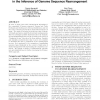Free Online Productivity Tools
i2Speak
i2Symbol
i2OCR
iTex2Img
iWeb2Print
iWeb2Shot
i2Type
iPdf2Split
iPdf2Merge
i2Bopomofo
i2Arabic
i2Style
i2Image
i2PDF
iLatex2Rtf
Sci2ools
RECOMB
2004
Springer
2004
Springer
Chromosomal breakpoint re-use in the inference of genome sequence rearrangement
In order to apply gene-order rearrangement algorithms to the comparison of genome sequences, Pevzner and Tesler [9] bypass gene finding and ortholog identification, and use the order of homologous blocks of unannotated sequence as input. The method excludes blocks shorter than a threshold length and ignores small block-internal rearrangements. Here we investigate possible biases introduced by eliminating and amalgamating short blocks, focusing on the notion of "breakpoint re-use" introduced by these authors. Analytic and simulation methods show that re-use is very sensitive to threshold size and to parameters of the rearrangement process. As is pertinent to the comparison of mammalian genomes, large thresholds in the context of high rates of small rearrangements risk randomizing the comparison completely. We suggest a number of mathematical, algorithmic and statistical lines for further developing the PevznerTesler approach. Categories and Subject Descriptors F.2.2 [Analysis...
Computational Biology | Keywords Comparative Genomics | Method Excludes Blocks | Problems General Terms | RECOMB 2004 |
| Added | 03 Dec 2009 |
| Updated | 03 Dec 2009 |
| Type | Conference |
| Year | 2004 |
| Where | RECOMB |
| Authors | David Sankoff, Phil Trinh |
Comments (0)

